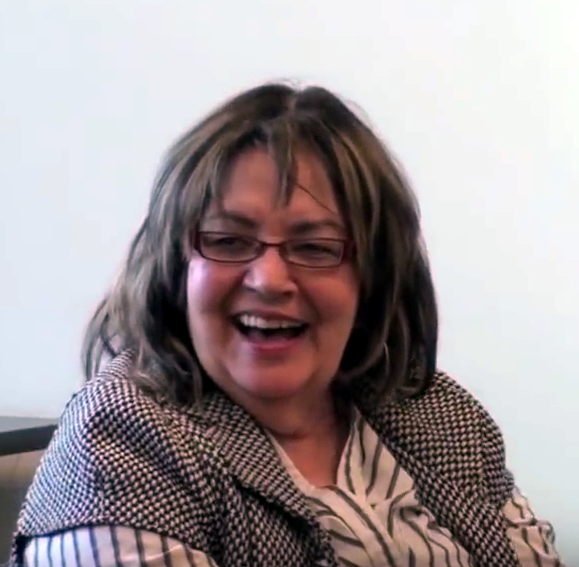Bonnie Devine, artist, writer, professor (born 12 April 1952 in Toronto, ON). A member of the Serpent River First Nation, Bonnie Devine is a prominent Ojibwe artist and writer. She has applied Ojibwe mythology and storytelling traditions to drawing, painting, sculpture, site-specific interventions, performance and video. She held a solo exhibition, The Tecumseh Papers, at the Art Gallery of Windsor in 2013. She was also featured with other Indigenous artists in Anishinaabe Artists of the Great Lakes at the Art Gallery of Ontario. She is an Associate Professor at the Ontario College of Art and Design University and is the founding chair of the school’s Indigenous Visual Culture Program. She received a Governor General’s Award in Visual and Media Arts in 2021.
Education
Though Devine was born and raised in Toronto, she is a member of the Serpent River First Nation. She has maintained a deep connection to the Serpent River region of north-central Ontario. Devine returned to school in her 40s. In 1997, she earned an AOCAD (Associate of OCAD University diploma) with Honours in Fine Arts and an emphasis in sculpture and installation from the Ontario College of Art and Design University. She graduated with an MFA from York University in 1999.
Early Career
From early on, Devine’s work has explored what has happened to the Indigenous peoples and to the land itself in the Serpent River region of north-central Ontario. Devine has applied Ojibwe mythology and storytelling traditions to drawing, painting, sculpture, site-specific interventions, performance and video. Smallpox Blankets (1995) is a mixed media work that consists of five sculptural wall pieces that look like old mud-stained blankets. Alluding to the ways in which Indigenous peoples were infected with, and decimated by, smallpox-infected blankets, the piece also looks like geological maps of polluted landscapes. Earth-Braid (1999) is a long braid of woven grass laid out on the ground, suggesting the ways in which human life, and perhaps especially women, and the earth itself are braided one into the other.
Devine’s two series of mixed media drawings, Book of Transformation (1999) and Book of Radiance (1999), are occasionally visionary and ecstatic. They also address issues of the sullying of the landscape by industry, and by uranium mining in particular. One piece in Book of Transformation which has the caption “and two nights I waited,” depicts purple bands descending from a glowing moon over a landscape of rolling hills at night; one senses that what is being waited for is a mythic, even redemptive, vision. In a piece from Book of Radiance bearing the caption “We lived in a mysterious country,” shapes are arranged on a steep green slope that rises to the horizon, the sky smudged with white clouds. In order to respect the natural world as sacred, the piece implies, it must also retain its mystery for us.
Devine’s first major solo exhibition was Radiation and Radiance at Gallery 1313 in Toronto in 1999. It was followed by Time/Space/Presence at A Space Gallery in Toronto in 2000. In 2003–04, her solo exhibition Stories from the Shield toured to various locations across Canada, including the Ojibwe Cultural Centre on Manitoulin Island, Ontario; the Justina M. Barnicke Gallery, Hart House, University of Toronto; the Art Gallery of Sudbury; and the Urban Shaman Gallery in Winnipeg.
Writing and Curating
Devine curated the exhibition of the work of Governor General’s Award-winning Ojibwe artist Daphne Odjig, The Drawings and Paintings of Daphne Odjig: A Retrospective, which toured various Canadian venues, including the National Gallery of Canada, between 2007 and 2010. She wrote an essay for the exhibition catalogue that accompanied the show. Devine also wrote a catalogue essay for an exhibit of the work of Anong Beam (Carl Beam’s daughter) at the Latcham Gallery in Stouffville, Ontario.
Recent Projects
Devine’s 2010 exhibition, Medicine Basket, Body Bags, at the Station Gallery in Whitby, Ontario, continued her exploration of the devastation brought to Ontario’s northern lakes, rivers, and land by uranium mining. One of the exhibit’s principal pieces, Canoe, features a full-sized canoe sheathed in paper over which is drawn (in tar) and written what has happened to these places. For Devine, the stories written directly on a canoe brings those stories closer to their source — the water and the land. And for Devine, the pollution is not merely physical; it is one of the ways western technology and industrial capitalism have conspired to steal the earth’s spirit.
For The Tecumseh Papers at the Art Gallery of Windsor in Windsor, Ontario, Devine used two 19th century terracotta sculptures by Hamilton MacCarthy — Tecumseh (1896) and Brock (1896) — as sources of inspiration. She used paintings, drawings, installations, and videos to both pay tribute to Tecumseh and to explore the ways in which the Royal Proclamation of 1763, the Treaty of Greenville of 1795, and the Treaty of Ghent of 1814 all impacted the lives of Indigenous peoples in the region.
In 2021, Devine received a Governor General’s Award in Visual and Media Arts for her “impactful art practice, commitment to bringing forth an Indigenous voice, [and] contribution to revisionist research and post-secondary education—particularly for Indigenous students.”
See also Important Indigenous Artists; Contemporary Indigenous Art in Canada.

 Share on Facebook
Share on Facebook Share on X
Share on X Share by Email
Share by Email Share on Google Classroom
Share on Google Classroom







